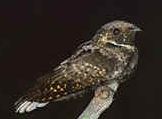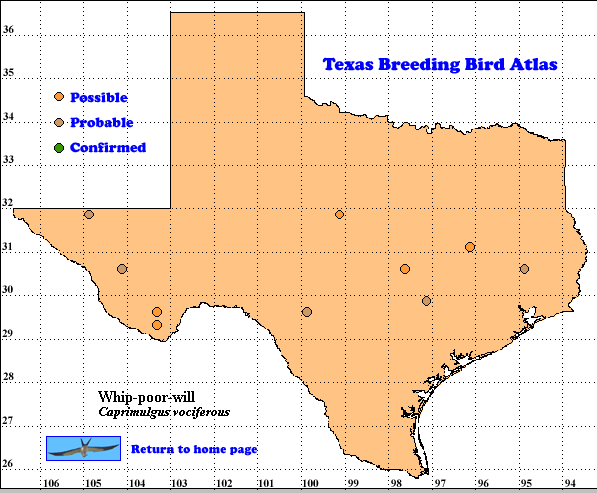The Whip-poor-will is the classic nightjar, named for its distinctive song and made famous in poetry and song. Although its song is familiar to many people, few have actually seen a Whip-poor-will because of its cryptic plumage and nocturnal habits. This species breeds in eastern North America from southern Canada to the southern United States and from west Texas to Arizona and south into Central America. The primary winter range lies in Central America, but a few individuals may winter along the Gulf Coast in the United States.Most of the Whip-poor-wills found in Texas are migrants, which may complicate the interpretation of breeding evidence. Migration in Texas starts in late March and may last until the middle of May (Oberholser 1974). Thus, atlasers had to be careful when assigning breeding status to Whip-poor-wills in early May. Further complicating matters is the fact that these birds may initiate breeding in early May. Most of the TBBAP records for early May are of possible breeding status and may represent migrants. The most desirable solution was to confirm breeding. Unfortunately, none of the records are for confirmed breeding.
DISTRIBUTION: In Texas, the Whip-poor-will occurs in the eastern half of the state and in the high mountains of the Trans-Pecos region. In the east, the few records indicate that the Whip-poor-will should be considered a rare and very local breeding bird. This nightjar is fairly common in the Trans-Pecos region above 1676 m (5,500 ft) where it is associated with pine-juniper-oak woods in brushy canyons and mountain slopes (Oberholser 1974).
SEASONAL OCCURRENCE: The Whip- poor-will is a difficult species to confirm, with no confirmed breeding records of the 15 total records obtained by the TBBAP. This largely nocturnal nightjar is difficult to find without an observer being audibly alerted to its presence. While roosting or incubating during the day, the Whip-poor-will is beautifully camouflaged and thus is rarely seen. TBBAP records reflect this. All of the records represent some form of vocal activity. An observer is even less likely to find a nest than to see a Whip-poor-will. An incubating adult is reluctant to flush and give away its nest location. The breeding season of the Whip-poor-will in Texas is long, extending from mid-April (Oberholser 1974) to early August (Bent 1940). TBBAP data do not indicate earlier or later breeding dates.
BREEDING HABITAT: For nesting, the Whip-poor-will prefers dry woodlands, but will occasionally nest in wet woods at the edge of a marsh. It breeds in open woods with adjacent fields and open areas that the birds use as foraging sites. The Whip-poor-will lays its two eggs on dry, well drained ground, often on the open forest floor. In the Trans-Pecos region, a bird may place its eggs under a small bush (Bent 1940). No material is added to the nest and the eggs rest either on fallen leaves or on bare ground. A small depression may result from the weight of the incubating adult. Incubation is performed by the female, but the male may contribute (Babcock 1975). The Whip poor- will occasionally may be double-brooded (Mills 1986), but this has not been reported for Texas.
The Whip-poor-will forages visually and is thus more active on moonlit nights than on nights without moonlight (Cooper 1981). As a result, breeding seems to be linked to the lunar cycles (Mills 1986). Hatching tends to occur with a waxing moon. As a result, the first two weeks of life for a nestling are synchronized with the greatest period of moonlight to aid foraging parents. The young gain independence during the maximum moonlit period of the next lunar cycle when foraging conditions are optimum.
STATUS: The Whip-poor-will is on the Blue List (Tate 1986) with declines being attributed to habitat loss and the scarcity of large moths on which it feeds (Robbins et al. 1986). Cattle grazing in the open woodlands in which it nests could adversely affect nesting success (Bent 1940). Its status in Texas is difficult to determine from the low number of records obtained by the TBBAP. For the eastern race (C. v. vociferus), Oberholser (1974) shows breeding records only for the northeastern part of Texas, but states that it is probably extirpated in that region as a breeding species. Pulich (1988) indicates that while there are old nesting records for north central Texas, there are no recent records. However, Breeding Bird Survey data show a slight increase in northeastern Texas (Sauer et al. 1995). It is unclear whether the TBBAP data genuinely reflect the loss of breeding in the northeast or reflect the difficulties in accurately atlasing the Whip-poor-will.
In the remainder of the eastern half of Texas, a variety of local checklists only show the Whip-poor-will to be present during migration. The T.O.S. Checklist (Texas Ornithological Society 1994) supports this view. Of the TBBAP data for eastern Texas, the record for latilong 29097, quad G1 for multiple singing males on 6 June provides the strongest evidence for breeding.
In the Trans-Pecos, the western race (C. v. arizonae) seems to be holding its own. Although known to breed in the Chisos and Guadalupe Mountains, Oberholser (1974) laments the failure of this bird to use apparently suitable habitat in the Davis Mountains.However, TBBAP data (30104-F1 and F2) are not the first to document their presence. The T.O.S. Checklist (Texas Ornithological Society 1994) lists it as a common summer resident. The record north of the Chisos Mountains (29103-F3) is in an area not previously known to support a breeding population. However, no date is known for this record and so it may represent a migrant.
Text by Cade L. Coldren (ca. 1997)
Literature Cited
Babcock, R. E. 1975. Another instance of incubation by a male Whip-poor-will. Wilson Bull. 87: 284.
Bent, A.C. 1940. Life histories of North American cuckoos, goatsuckers, hummingbirds, and their allies. U.S. Nat. Mus. Bull. No. 176.
Cooper, R .J. 1981. Relative abundance of Georgia caprimulgids based on call-counts. Wilson Bull. 93: 363-371.
Mills, A. M. 1986. The influence of moonlight on the behavior of goatsuckers (Caprimulgidae). Auk 103: 370-378.
Robbins, C. S., D. Bystrak, and P .H. Geissler. 1986. The breeding bird survey: Its first fifteen years, 1965-1979. U.S. Fish Wildl. Serv., Resour. Publ. 157.
Sauer, J. R., B. G. Peterjohn, S. Schwartz, and J. E. Hines. 1995. The North American Breeding Bird Survey Home Page. Version 95.1. Patuxent Wildlife Research Center, Laurel, MD.
Tate, J., Jr. 1986. The blue list for 1986. Am. Birds 40: 227-236.
Texas Ornithological Society. 1994. TOS Checklist for the birds of Texas. 3rd Ed.

